Art Deco and Jazz Moderne [Part 2]
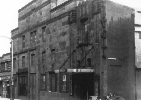
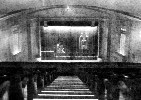 |
In appearance, the New Tivoli in Edinburgh (1934) followed a similar
pattern, but appears to have been more generously financed as its
equally lumpish façade to Gorgie Road was faced with red
sandstone.
The interior of this cinema (now a bingo hall) remains in
excellent near-original condition, however, with acid-etched in
‘jazz moderne’ style in the door architraves and many other period
details. As with the Mecca, the auditorium of this cinema was largely
clad in asbestos cement panels, but this was buried from view behind a
continuous street frontage.
McKissack’s other main client, George Singleton, was a man of
advanced ideas. Describing his first purpose-built cinema, the Broadway
in Shettleston, Singleton explained his own philosophy about cinema
design: |
We found a site just off Shettleston Road. It was cramped and on an
awkward corner and James McKissack was asked to make a very conspicuous
entranceway that could be seen from Shettleston Road. It didn't matter
what it looked like as long as it was eye catching and everyone could
see that it was there. He did us proud. James Welsh chose the name to
match up with his other halls and it had the right Hollywood feel. I
was very proud of the Broadway. It was my first big achievement when I
went into the cinema trade and it cost £30,000; not much in
today's terms may be, but a great deal then.
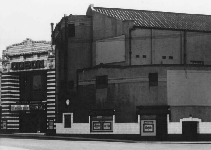 |
The Broadway did indeed boast the prominent corner portico ordered by
its owner; almost three storeys high, it was clad in stripes of blue
and cream tiling. This, however, was rather dominated by the intrusive
bulk of the auditorium looming behind. As to the interiors, which were
largely unornamented:
We never felt that ornate decoration would be needed because we always
showed films in continuous performances and usually started them before
the audience was allowed in, so they rarely saw the auditorium with the
lights on. This trick also spared electricity and in that respect our
cinemas were ahead of their time as simple interiors became standard
practice for everyone later in the thirties…
|
McKissack went on to design further Singleton cinemas - the
Commodore,
Scotstoun (1933) and the
Vogue cinemas in Rutherglen and Strathmartine
Road,
Dundee (both 1936). These were all similar in that they had
freestanding tiled entrance porticos, flanged by shop units, with
commodious entrance hallways. Their auditoria were located on vacant
land some way to the rear (in the cases of Scotstoun and Dundee, these
were at right angles to the street frontages). Intriguingly, and in
complete contrast to the Mecca Possil, all three were solidly constructed with
reinforced concrete frames containing brick infill. All appear to have
had rather plain interiors, mixing neo-classical details with Art Deco
motifs. As ever, McKissack tended to emphasise door architraves and
proscenium arches with applied decoration as audiences in the semi-dark
most readily noticed these features.
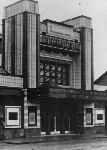
Commodore, Scotstoun |
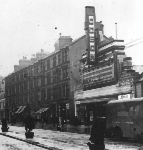
Vogue, Rutherglen |
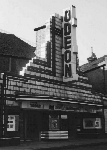
Vogue, Dundee |
Also in Dundee was the Empire in Rosebank Street, a former music hall,
purchased by George Singleton in 1927 and extensively modernised by
McKissack in 1934. A completely new entrance was made possible by the
demolition of some adjoining houses. This comprised a large yellow,
cream and brown faience-clad portico with a neon-lit canopy; a large
neon sign announcing the name of the theatre. The entire balcony was
re-seated and the walls were decorated in a scheme of orange and brown
and gold.
That September, Singleton sold his entire circuit to Oscar
Deutsch’s expansive Odeon Empire, which was anxious to gain a
Scottish foothold. Apart from the four modern super cinemas described
above, the remainder of the Singleton circuit consisted of venerable
halls – such as the
Paragon in Glasgow’s Gorbals, converted
from an abandoned church in the early days of cinema and subsequently
little improved. Singleton later recalled that he only sent Deutsch
photographs of his most recent cinemas and that Odeon paid well over
the odds for the entire business, believing that all the cinemas were
of a similar standard. Scruffy as some were, they were all good
earners and at least Odeon gained Scottish representation in towns as
far apart as Hawick, Dundee and Coatbridge as a result.